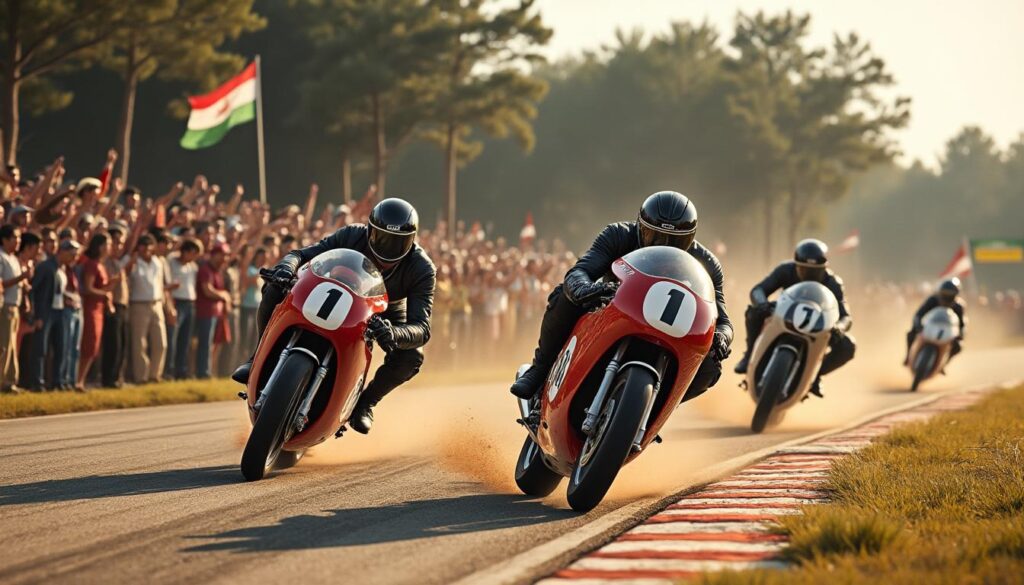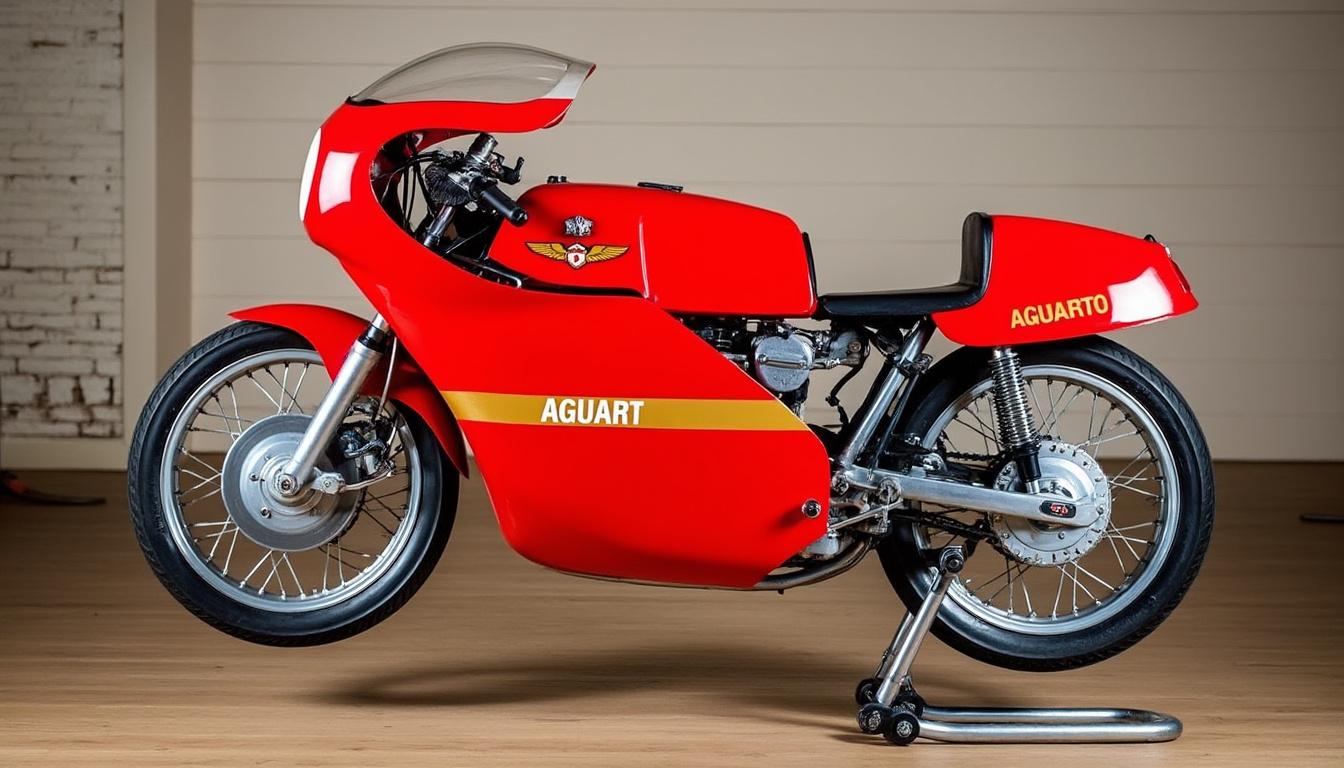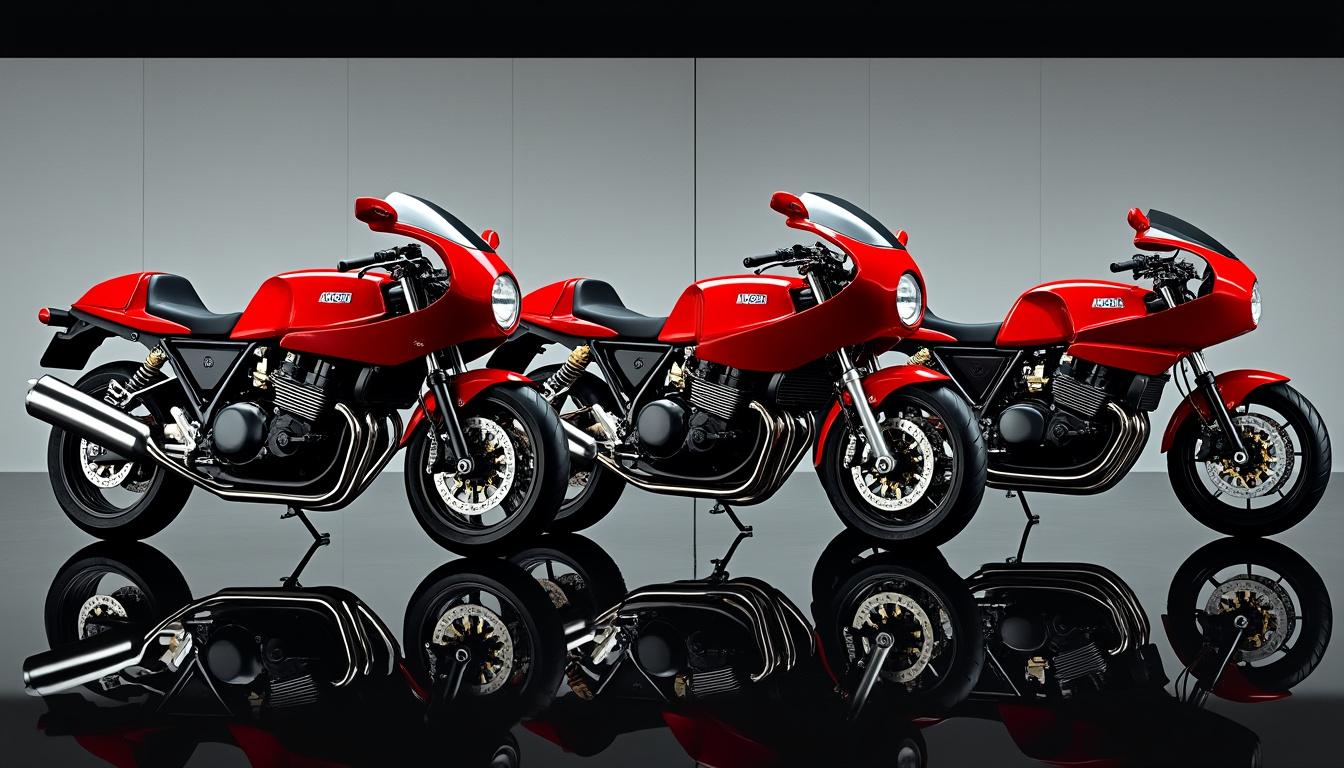dive into the history of MV Agusta in Moto GP between 1957 and 1976

MV Agusta is much more than just a motorcycle brand; it represents excellence and innovation in the world of competition. Since its beginnings, this Italian brand has made a name for itself in the Moto GP universe, particularly between 1957 and 1976, an emblematic period marked by breathtaking performances, legendary riders, and iconic machines. The stories surrounding MV Agusta are a true dive into the technical challenges of racing and the passion of the riders. Whether through the exploits of Giacomo Agostini, the innovative approach to engineering, or the intense rivalry with competing brands, each element contributes to the legend of this brand. For those who wish to delve into this heritage, a dedicated book offers a fascinating perspective on the sporting epic of MV Agusta and its contributions to the world of motorcycles. In this article, we will explore the different facets of this golden era, from the machines that made dreams come true to the evolution of competitions, including the stories of the riders who etched their names in history.
The beginnings of MV Agusta in Moto GP: a meteoric rise
The birth of MV Agusta in Moto GP began in 1957 with an unwavering desire to conquer. Although the brand's history began earlier, it was truly in this year that it entered the arena of Grand Prix racing. The first machines, the famous MV 350 and MV 500, stood out thanks to their performance and cutting-edge technology for the time. These motorcycles were notably characterized by being lightweight, fast, and agile—essential assets on the narrow and winding circuits of the era.
State-of-the-art technology
What truly propelled MV Agusta to the top was its ability to innovate. The development of powerful and reliable engines, combined with optimized chassis, allowed the brand to win numerous titles. The first races quickly translated into victories, attracting the best riders. Among them was Giacomo Agostini, who would become a living legend with an exceptional track record.
| Year | Model | Category | Result |
|---|---|---|---|
| 1957 | MV 350 | 350 cc | World Championship |
| 1958 | MV 500 | 500 cc | World Championship |
| 1966 | MV 3 cylinders | 500 cc | World Championship |
However, the beginnings were not without challenges. The competition with brands like Ducati and Norton was fierce. Each race represented a test not only for the riders but also for the engineers tasked with improving the machines. The teamwork between the riders and the technical teams was crucial, leading to unprecedented advancements in engineering and performance.

The era of heroes: the iconic riders of MV Agusta
If MV Agusta has made its mark in the world of Moto GP, it is also thanks to a group of exceptional riders. These men, true heroes of the competition, tested the capabilities of the machines while pushing the limits of racing. Among these figures, Giacomo Agostini undoubtedly stands out.
Giacomo Agostini: Legend of Moto GP
Agostini, nicknamed "Ago," thrilled crowds with his spectacular performances. With his unique riding style and ability to handle pressure, he accumulated an exceptional record, winning a total of 15 world titles—a feat unmatched for decades. His victories allowed MV Agusta to establish a respected name in the history of motorcycles.
- World Championships: 15 titles
- GP Wins: 68 races
- Motorcycle brands ridden: MV Agusta, Bultaco
Another iconic personality is Mike Hailwood, a British rider who also left an indelible mark. With his flamboyant talent, he alternated victories with those of Agostini, creating a friendly rivalry that captivated competition lovers. Hailwood brought a unique racing strategy, combining raw speed with technical mastery, thus contributing to the evolution of motorcycle racing.
| Rider | World Title | Years of Competition |
|---|---|---|
| Giacomo Agostini | 15 times | 1957-1976 |
| Mike Hailwood | 9 times | 1958-1967 |
| John Surtees | 4 times | 1956-1966 |
These riders were not just competitors; they were visionaries, exploiting every aspect of the MV Agusta machines to refine their performances. The legacy of these racers endures today, inspiring new generations of aspiring riders to take to the circuits.
The iconic machines: innovation and performance of MV Agusta
The motorcycles of MV Agusta are not just racing vehicles; they represent a technological advance in the field of motorcycling. Beyond their sleek aesthetics and refined engineering, these machines testify to the importance of innovation during the years 1957 to 1976. Each model launched on the market featured unique characteristics, whether in terms of engine, chassis, or design.
Revolutionary models
The 1957 model saw the introduction of the first six-cylinder motorcycle: the MV 6 cylinders. This innovation marked a turning point in the design of racing motorcycles. By integrating advanced engine technology, it achieved an unparalleled power-to-weight ratio. This model allowed MV Agusta riders to better manage the race, thus increasing their speed and performance on the track.
- MV 350: Numerous victories due to its lightweight.
- MV 500: Designed for racers, combining power and control.
- MV 6 cylinders: Unique for the time, with lightning-fast top speed.
Each model was designed with a meticulous attention to detail that captured the public's imagination. For example, the MV 500 triple, developed in the 1960s, demonstrated the incredible craftsmanship of engineers who integrated racing technologies directly into the design of motorcycles intended for consumers. This world champion was built to conquer the tracks, using lightweight materials and a powerful engine—two elements that set it apart from its competitors.
| Model | Engine Type | Power (hp) | Top Speed (km/h) |
|---|---|---|---|
| MV 350 | 2 strokes, single-cylinder | 35 | 180 |
| MV 500 | 4 strokes, 4 cylinders | 50 | 200 |
| MV 6 cylinders | 6 cylinders | 75 | 220 |

The rivalry in Moto GP: MV Agusta vs. the competition
During the two decades between 1957 and 1976, MV Agusta faced numerous rivals on the Moto GP stage. The competition became fierce, and each manufacturer attempted to outdo the others with technological innovations and unprecedented commitment. Brands like Ducati, Norton, and Yamaha pressured MV Agusta, forcing the brand to react to maintain its leading position.
A fierce battle on the track
The competition with Ducati, in particular, was marked by constant exchanges of victories. As Ducati launched its powerful V-Twin models, MV Agusta had to find creative ways to optimize its machines. This context of rivalry led to a surge of innovation that significantly contributed to the evolution of Moto GP as a whole.
- Racing strategies: Adaptation of riding techniques.
- Technical innovations: Improvement of suspension and braking systems.
- Physical training: Training of riders to maximize performance.
Meanwhile, this competition sparked growing enthusiasm for motorcycle racing, captivating the attention of the media and the public. Competitions became a true spectacle, where teams competed in skill and boldness to stand out.
| Brand | Engine Type | Competitive Advantage |
|---|---|---|
| MV Agusta | 4 cylinders, 6 cylinders | Performance and handling |
| Ducati | V-Twin | Torque and power |
| Norton | 4 cylinders | Proven technology |
An enduring legacy: MV Agusta and its impact on Moto GP
As we conclude this dive into the history of MV Agusta between 1957 and 1976, it is essential to recognize the lasting impact of this brand on the world of Moto GP. The contributions and engineering innovations established new standards for racing circuits and redefined what it meant to be a performance motorcycle manufacturer.
A persistent influence
The legacy of MV Agusta does not lie solely in its victories. The technical innovations and racing methods developed during these years continue to influence generations of riders and manufacturers today. Technologies such as advanced aerodynamics, lightweight materials, and sophisticated engine management systems are elements still found in modern motorcycles.
- Innovations: Modern telemetry systems stemming from the MV Agusta era.
- Rider training: Techniques inspired by the champions of the 60s and 70s.
- Passion for motorcycles: The culture of competition is nurtured by these legends.
Those wishing to explore this rich history further will be delighted to discover Alan Cathcart's book, MV Agusta – Moto GP 1957-1976, a book that unveils the behind-the-scenes of this exciting adventure. The pages are filled with unique anecdotes and technical insights allowing an even greater appreciation of the performance of the brand's iconic machines. Available in a limited edition, this book is a true gem for motorcycle and sports history enthusiasts.
The passion for MV Agusta endures through time, and the memories of victories continue to appeal not only to enthusiasts but also to newcomers in the world of Moto GP. The legend of MV Agusta is still being written, and it will be interesting to follow its evolution in the coming years.
Source: www.lerepairedesmotards.com
Leave a Reply



Articles relatifs